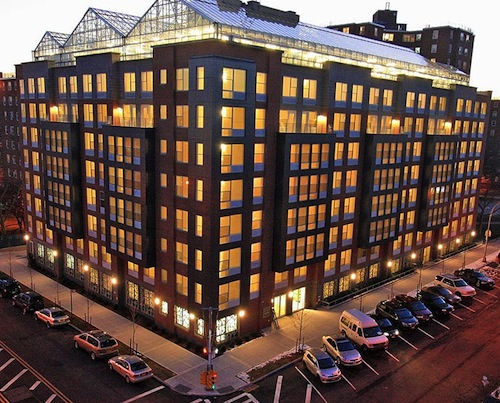The New York City Housing Authority has opened Arbor House, a 124-unit complex in the Morrisania neighborhood of the Bronx. The LEED Platinum building includes energy-efficient HVAC, a "green wall" lobby feature, and a 10,000-sf hydroponic farm on the roof.
Designed by ABS Architects, the $37.7 million facility is the result of a collaboration between the NYCHA, the NYC Department of Housing Preservation and Development, and Blue Sea Development. The public-private initiative was part of a city program to recruit private companies to develop dilapidated and vacant NYCHA land. About 2,000 units in the program are currently under construction or in pre-development in Manhattan, the Bronx and Brooklyn.
Arbor House, an eight-story building, contains 16 studios, 33 one-bedroom apartments, and 75 two-bedroom apartments, plus superintendent quarters. Residents must earn less than 60% of the area median income ($49,800 for a family of four). Residents will start moving in during the next few weeks. HPD spokesperson RuthAnne Visnauskas says the city is pushing for more sustainable design in its public housing facilities. The rooftop farm, a first for the agency, will be operated by third party Sky Vegetables and is expected to generate money by selling produce commercially, with some of the yield set aside for building residents and other local families.
About $37 million of the project cost was subsidized via local, state, and city subsidies, Reso A funds, tax credit equities, and tax-exempt bonds.
(http://observer.com/2013/02/an-arbor-in-the-forest-green-affordable-housing-development-opens-in-the-bronx/)
Related Stories
Mixed-Use | Jun 6, 2023
Public-private partnerships crucial to central business district revitalization
Central Business Districts are under pressure to keep themselves relevant as they face competition from new, vibrant mixed-use neighborhoods emerging across the world’s largest cities.
Multifamily Housing | Jun 6, 2023
Minnesota expected to adopt building code that would cut energy use by 80%
Minnesota Gov. Tim Walz is expected to soon sign a bill that would change the state’s commercial building code so that new structures would use 80% less energy when compared to a 2004 baseline standard. The legislation aims for full implementation of the new code by 2036.
Healthcare Facilities | Jun 5, 2023
Modernizing mental health care in emergency departments: Improving patient outcomes
In today’s mental health crisis, there is a widespread shortage of beds to handle certain populations. Patients may languish in the ED for hours or days before they can be linked to an appropriate inpatient program.
Student Housing | Jun 5, 2023
The power of student engagement: How on-campus student housing can increase enrollment
Studies have confirmed that students are more likely to graduate when they live on campus, particularly when the on-campus experience encourages student learning and engagement, writes Design Collaborative's Nathan Woods, AIA.
Engineers | Jun 5, 2023
How to properly assess structural wind damage
Properly assessing wind damage can identify vulnerabilities in a building's design or construction, which could lead to future damage or loss, writes Matt Wagner, SE, Principal and Managing Director with Walter P Moore.
Cladding and Facade Systems | Jun 5, 2023
27 important questions about façade leakage
Walter P Moore’s Darek Brandt discusses the key questions building owners and property managers should be asking to determine the health of their building's façade.
Retail Centers | Jun 2, 2023
David Adjaye-designed mass timber structure will be a business incubator for D.C.-area entrepreneurs
Construction was recently completed on The Retail Village at Sycamore & Oak, a 22,000-sf building that will serve as a business incubator for entrepreneurs, including emerging black businesses, in Washington, D.C. The facility, designed by Sir David Adjaye, the architect of the National Museum of African American History and Culture, is expected to attract retail and food concepts that originated in the community.
Mixed-Use | Jun 1, 2023
The Moore Building, a 16-story office and retail development, opens in Nashville’s Music Row district
Named after Elvis Presley’s onetime guitarist, The Moore Building, a 16-story office building with ground-floor retail space, has opened in Nashville’s Music Row district. Developed by Portman and Creed Investment Company and designed by Gresham Smith, The Moore Building offers 236,000 sf of office space and 8,500 sf of ground-floor retail.
Healthcare Facilities | Jun 1, 2023
High-rise cancer center delivers new model for oncology care
Atlanta’s 17-story Winship Cancer Institute at Emory Midtown features two-story communities that organize cancer care into one-stop destinations. Designed by Skidmore, Owings & Merrill (SOM) and May Architecture, the facility includes comprehensive oncology facilities—including inpatient beds, surgical capacity, infusion treatment, outpatient clinics, diagnostic imaging, linear accelerators, and areas for wellness, rehabilitation, and clinical research.
K-12 Schools | May 30, 2023
K-12 school sector trends for 2023
Budgeting and political pressures aside, the K-12 school building sector continues to evolve. Security remains a primary objective, as does offering students more varied career options.

















